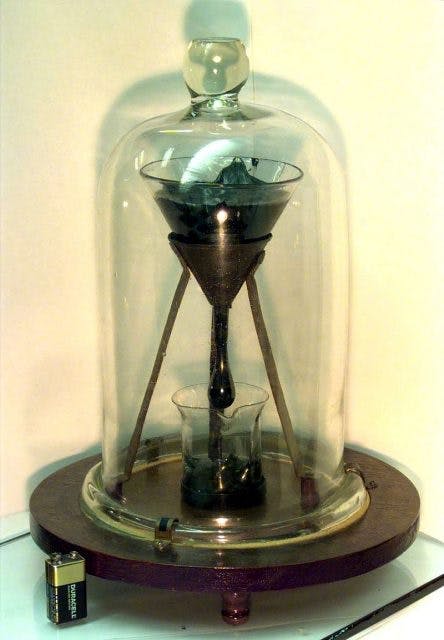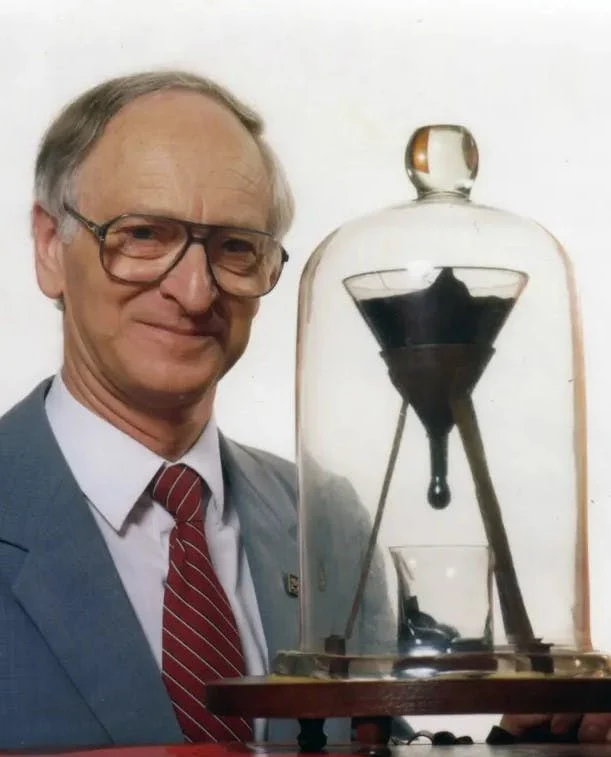In a world of instant results and quick solutions, there exists a scientific experiment that demands the ultimate patience. Tucked away at the University of Queensland in Australia sits a funnel with what appears to be a solid black substance that hasn’t moved much since 1927. This is the famous Pitch Drop Experiment—certified by Guinness World Records as the longest running lab experiment in history. It has outlived its creator, fascinated generations of scientists, and continues to challenge our perception of matter and time.
What Is the Pitch Drop Experiment?
The Pitch Drop Experiment began in 1927 when Professor Thomas Parnell, the first physics professor at the University of Queensland, set out to demonstrate an important scientific concept: appearances can be deceptive. His subject was pitch—a thick, black, tar-like material commonly used for waterproofing boats and roads.
To the touch, pitch feels completely solid and brittle at room temperature. You might think you could shatter it with a hammer. But Parnell wanted to prove something remarkable—that despite its solid appearance, pitch is actually an extremely viscous liquid that flows at an incredibly slow rate.
The experiment setup is elegantly simple:
- Parnell heated a sample of pitch and poured it into a sealed glass funnel
- He allowed it to cool and settle for three years
- In 1930, he cut the stem of the funnel, allowing the pitch to begin its glacially slow descent
The first drop fell in December 1938—eight years after the funnel was cut. Since then, only nine drops have fallen in total, with each drop taking approximately 8-13 years to form and fall.

The Science Behind the Incredibly Slow Drip
Why does pitch behave this way? The answer lies in its classification as a viscoelastic substance. Viscoelastic materials exhibit both viscous properties (like honey or molasses) and elastic properties (like rubber).
At room temperature, pitch appears solid because its molecules move extremely slowly—so slowly that we can’t perceive the movement. However, when subjected to a constant force over time (like gravity pulling it through a funnel), it will eventually flow.
How slow is this flow? Scientists have calculated that pitch is approximately 230 billion times more viscous than water. To put this in perspective:
- Water has a viscosity of about 1 millipascal-second (mPa·s)
- Honey has a viscosity of about 10,000 mPa·s
- Pitch has a viscosity of roughly 230 billion mPa·s
This extraordinary viscosity explains why the pitch appears solid in the short term but behaves as a liquid over decades.

A Timeline of Patience: The Nine Drops So Far
Since the experiment began, only nine drops have fallen:
- December 1938 – The first drop fell eight years after the funnel was cut
- February 1947 – Nearly nine years after the first drop
- April 1954 – Just over seven years later
- May 1962 – Eight years from the previous drop
- August 1970 – Another eight-year interval
- April 1979 – Nearly nine years later
- July 1988 – After another nine-year wait
- November 2000 – The longest interval yet at twelve years
- April 2014 – Almost fourteen years later
The tenth drop is currently forming and, based on recent patterns, might fall sometime in the next decade.

The Elusive Moment: No One Has Ever Seen a Drop Fall
Perhaps the most fascinating aspect of the longest running lab experiment is that in its 96-year history, no human has ever witnessed the moment a drop actually falls. This remarkable fact isn’t due to lack of trying—it’s simply a matter of timing and luck.
Professor John Mainstone, who took over custodianship of the experiment in 1961, dedicated decades to observing it. He came tantalizingly close to witnessing drops fall on three separate occasions:
- In 1979, he missed the seventh drop while getting a cup of tea
- In 1988, he missed the eighth drop due to a brief absence during a weekend vigil
- In 2000, a camera malfunction prevented recording the ninth drop
Mainstone passed away in 2013, never having witnessed a drop fall despite monitoring the experiment for 52 years. The ninth drop fell in 2014, after his death.

Modern Monitoring: The Webcam Era
Determined not to miss future drops, the University of Queensland installed a webcam in 2000 to continuously monitor the experiment. Unfortunately, when the eighth drop fell, it coincided with a camera malfunction.
Today, thanks to improved technology, three webcams constantly observe the experiment, streaming live to viewers worldwide. Anyone with an internet connection can now watch the pitch drop experiment in real-time through the university’s website.
Despite this technological vigilance, the ninth drop in 2014 still managed to fall without being directly observed—it happened during a server outage when the cameras weren’t recording.
Environmental Factors: What Affects the Drop Rate?
The time between drops isn’t consistent, and scientists have identified several environmental factors that influence how quickly the pitch flows:
- Temperature: Higher temperatures decrease viscosity, making the pitch flow faster
- Air conditioning: The installation of climate control in the building has affected the experiment
- Vibration: Building vibrations may slightly impact the flow rate
- Lighting: Heat from nearby lights can affect the temperature of the pitch
These variables make predicting the exact timing of the next drop challenging, adding another layer of intrigue to the experiment.
The Current Custodians: Continuing the Legacy
After Professor Mainstone’s passing in 2013, the experiment came under the care of Professor Andrew White and the School of Mathematics and Physics at the University of Queensland.
The current custodians maintain the experiment with the same dedication as their predecessors, ensuring that this remarkable demonstration of patience and scientific curiosity continues for future generations. With a fresh beaker in place to catch future drops, the experiment is set to continue for at least another century.
What Has the Pitch Drop Experiment Taught Us?
Beyond demonstrating the unusual properties of pitch, this experiment has provided broader scientific and philosophical lessons:
Scientific Value:
- It offers rare data on the behavior of extremely viscous substances over long periods
- It demonstrates how materials can exist in states between traditional classifications of solid and liquid
- It provides insights into molecular behavior at extreme viscosities
Philosophical Impact:
- It challenges our human perception of time and change
- It demonstrates the value of scientific patience and long-term thinking
- It serves as a reminder that some processes occur at timescales vastly different from human experience
Similar Experiments Around the World
The fame of the Queensland pitch drop experiment has inspired similar setups elsewhere:
- Trinity College Dublin: Began their own pitch drop experiment in 1944. In 2013, they captured the first-ever video of a pitch drop falling—something the original experiment has never achieved.
- Maritime College, University of Tasmania: Maintains a similar experiment started in the 1990s.
These “competitor” experiments provide valuable comparative data, though none has the longevity of the original Queensland experiment.
How to Watch the Pitch Drop Experiment Live
For those intrigued by this testament to scientific patience:
- Visit the University of Queensland’s Pitch Drop Experiment webpage
- Access the live webcam feed showing the current state of the experiment
- Join thousands of others around the world who periodically check in, hoping to be the first to witness a drop fall
The tenth drop is currently forming and may fall sometime in the 2020s, though exact predictions remain difficult.
Conclusion: A Lesson in Scientific Patience
In our fast-paced world of instant gratification and rapid technological advancement, the Pitch Drop Experiment stands as a powerful reminder that some natural processes unfold at their own unhurried pace. This simple setup of pitch in a funnel has outlasted its creator, survived World War II, witnessed the digital revolution, and continues to drip into the 21st century.
The experiment’s true value may lie not in any groundbreaking discovery, but in how it challenges us to think beyond human timescales. It reminds scientists and non-scientists alike that nature operates on multiple temporal dimensions—some processes happen in nanoseconds, while others take decades or centuries.
As the tenth drop slowly forms, we’re invited to participate in this unique scientific journey. Who knows? With the webcams in place, perhaps you could be the first person in history to witness a drop fall in this remarkable experiment that bridges generations through the simple, patient observation of a substance that defies easy classification.

 Additional Fun Facts
Additional Fun Facts
Pitcher
The word pitcher is said to derive from this long spouted container used to pour hot pitch
$150 Billion
The International Space Station is the most expensive experiment ever. It is a collaboration between global agencies, most notably: NASA, Roscosmos, JAXA, ESA, and CSA. It has state-of-the-art scientific equipment and facilities on board circles the Earth 408 kilometres above the surface.
2005
is the year John Mainstone and the late Thomas Parnell were awarded the Ig Noble Prize that honors achievements that make people laugh and think.




